You can connect the 3-phase induction motor in Star or Delta. The connection of the motor in star or delta depends on the stator coils’ voltage rating and the supply voltage to the stator. A three-phase induction motor has three sets of windings, one for each phase (U, V, and W). Each phase winding of the motor is divided into two coils (or groups of coils), thus there are six coil terminals in the motor. The internal construction and connections of the coil within the motor are determined during motor manufacturing.
Three-phase motor connections can be done in two ways:
- Star, and
- Delta
For the dual-voltage winding connections of a three-phase induction motor, the windings are configured as follows:
High-Voltage Configuration: In the high-voltage configuration, the two windings of each phase are connected in series to handle the higher voltage rating. The highest value of the supply voltage is shared equally between the windings, and the nominal current passes through each winding.
Low-Voltage Configuration: In the low-voltage configuration, the two windings of each phase are connected parallel to handle the lower voltage rating and higher current. Thus, the lower supply voltage is equally shared between the windings, and the nominal current passes through each winding.
Note that the low-voltage connection will draw twice the amount of current from the source compared to the high-voltage connection. Most motors display two values for voltage and current on their nameplates.
Thus, the motor with dual voltage operation has the same three sets of windings, but each phase winding is internally divided into two sections.
Three-phase motors have three independent windings. The stator holds all three windings in the stator slots. These windings are displaced 120 degrees electrically from each other. It is powered by a three-phase alternating current (AC) system.
The star connection configuration of the motor winding has four wires, and a delta connection has three wires. The induction motor is a balanced type of load and therefore, three wires are used in a star or delta connection. The neutral wire of the 4-wire-star supply system is not connected to the motor. The star-delta connection is used to start a three-phase AC induction motor. The star delta starter connects the motor winding first in the star, and then in the delta to limit the higher starting current.
What is a Three-Phase Motor?
A three-phase motor is an electric motor that operates on three phases of electrical power. This motor requires a three-phase alternating current (AC) for its operation. The AC supply fed to the motor’s stator produces a rotating magnetic field. The rotating magnetic field interacts with the rotor current and produces torque.
In a 3-phase motor, three motor windings can be connected in a star or delta configuration. In a star connection, three ends of the motor’s coils are connected to a common point, and the other three ends of the coils are connected to a 3-phase supply source. For example, if the endpoints of three coils are S1, F1, S2, F2, and S3, F3, then the F1, F2, and F3 or S1, S2, and S3 endpoints are connected and it forms a common point known as a neutral point.
On the other hand, in a delta connection, each end of the motor coil connects to the start of the next phase, allowing the system to be fed through the connection points. For example, if the three coils’ endpoints are S1, F1, S2, F2, and S3, F3, then the F1 is connected to S2, F2 is connected to S3, and the F3 is connected to S1. Thus, all three coils form a delta connection.
In a star connection, the current flowing through each phase equals the line current, while the voltage across each phase is (1/√3) of the line voltage. For example, if the line voltage is 440 volts, the voltage across each winding will be 440/√3=254 volts. Thus, the winding experiences approximately 58% of the line voltage in a star connection. Hence. windings need less insulation in a star configuration.
On the other hand, in a delta connection, the current in each phase is 1/√3 times the line current, while the voltage across each phase is the same as the line voltage. For example, if the line voltage is 440 volts, the voltage across each winding will be 440 volts. In a delta connection, winding experiences full line voltage, therefore the winding needs more insulation.
3-phase Asynchronous Motor
There are two types of 3-phase asynchronous or induction motors.
- Those with wound rotors belong to the class first. These are also called slip-ring motors.
- Class second is one with the rotor in a short circuit, also known as the squirrel cage rotor. This is due to its shape, which is similar to a cage.
The stator winding of both types of asynchronous motor has the same configuration and can be connected in star or delta. The rotor of the wound rotor is connected in a star connection through external resistances, while the star connection of the rotor is made inside the squirrel cage induction motor.
Now, we will discuss the configuration of Star and Delta and how to connect a 3-phase motor in Star and Delta.
Star-Delta Motor Connection
The stator of a 3-phase induction Motor has three windings, each with two ends. The first winding has ends called U and X or U1 and U2. The second winding, V and Y, is also called V1 and V2. The third winding W and Z, is also called W1 and W2. The winding U1-U2, V1-V2, and W1-W2 can be connected in a star or delta connection.
The 3-phase motor windings with their start and end points are shown in the figure below.
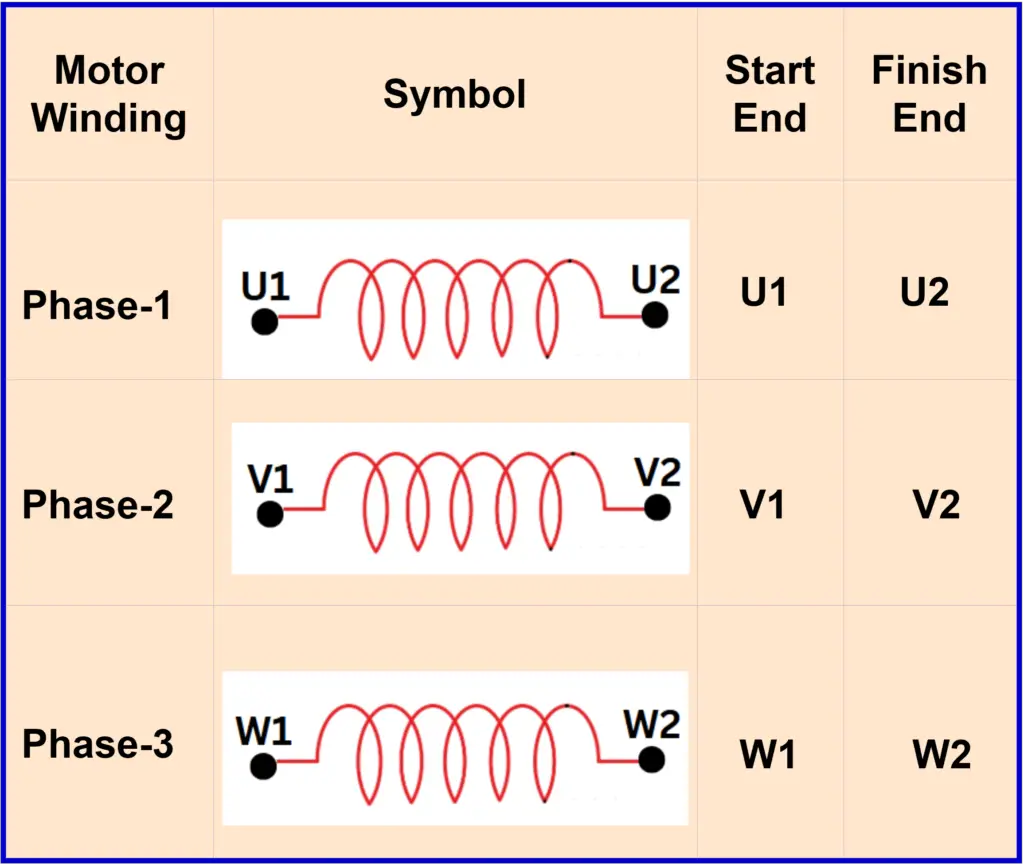
The choice between star and delta motor connections depends on the specific application for which the motor is used.
What is Star Connection?
Star connection, also known as a “Y connection,” connects the windings of a three-phase electrical system. Star connection is used in motors, generators, and transformers. In a star connection, the start or finish end of each winding is connected, and the common junction point of this connection forms a neutral point or star point (Y), while the other ends are connected to the three-phase lines.
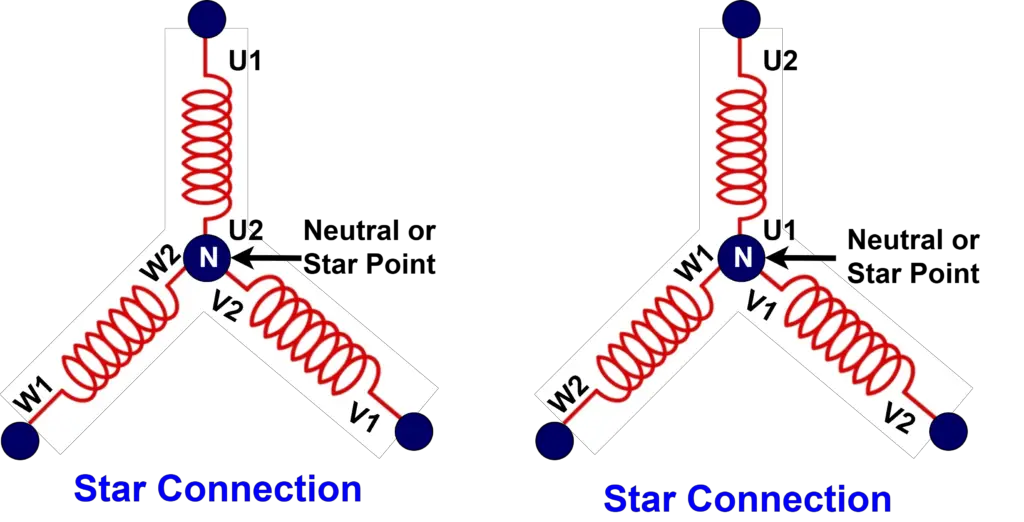
In a star connection, the center of the “Y” is created by joining the three motor terminals (U1, V1, and W1) or (U2, V2, and W2) at a common neutral point.
1. Star Motor Connection
Connecting a motor in a star (Y) configuration involves connecting each of the motor windings to a common point (neutral) and the other ends to the power supply phases.
The motor star connection is shown in the diagram below.

Step-by-step Procedure for Star Motor Connection
Step1: Identify the Motor Terminals
Three-phase motors have six terminals, typically labeled U1, U2, V1, V2, W1, and W2. The motor terminals and their labeling are shown in the image below.
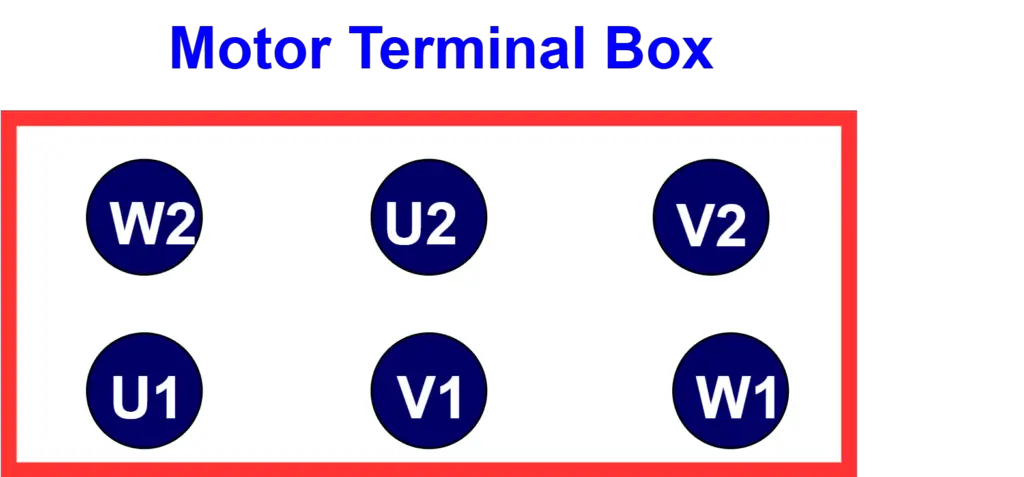
Step 2: Determine the Winding Pairs
The motor winding terminals are paired as U1-U2, V1-V2, and W1-W2. Each pair represents one of the motor windings. The motor windings pairs are shown in the figure below.

Step 3: Create a Neutral Point
Connect the ends of each winding (U2, V2, and W2) to form a common neutral point, the “star” point. The connection diagram is shown in the figure below.
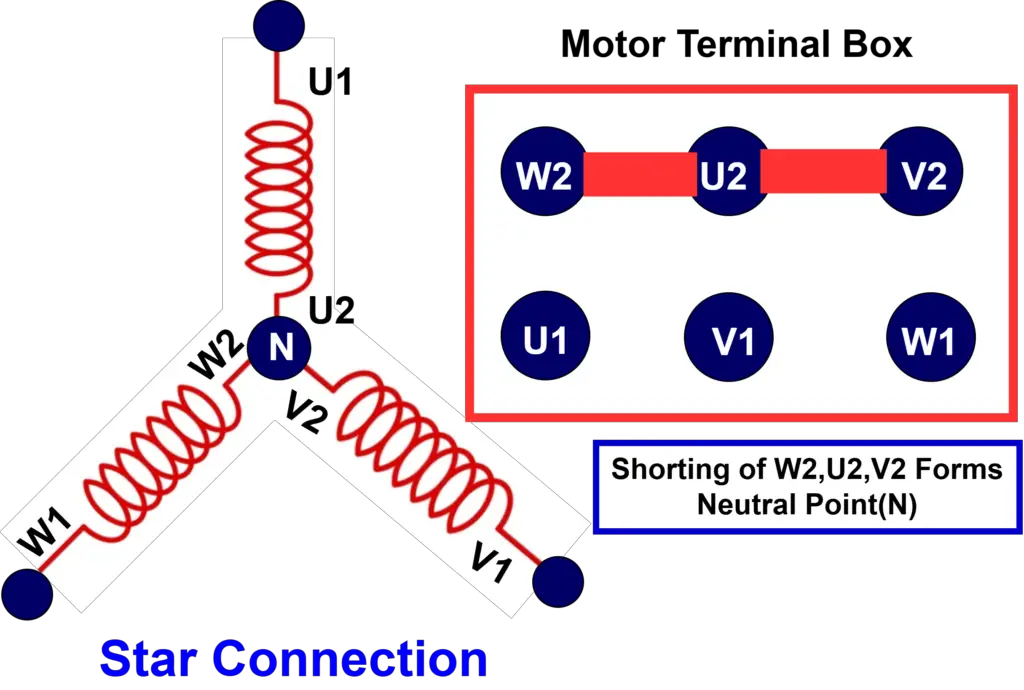
Step 4: Connect the Phases
Connect the remaining terminals (U1, V1, and W1) to the three-phase power supply. Each phase line (L1, L2, L3) is connected to one of these terminals.
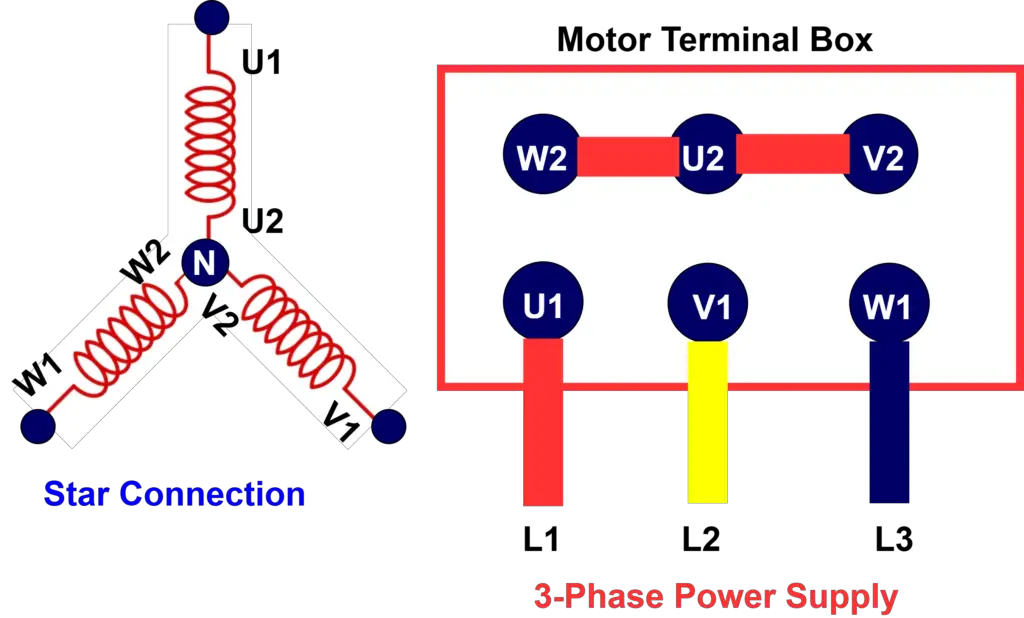
The diagram below shows how the motor windings are connected in the star connection.
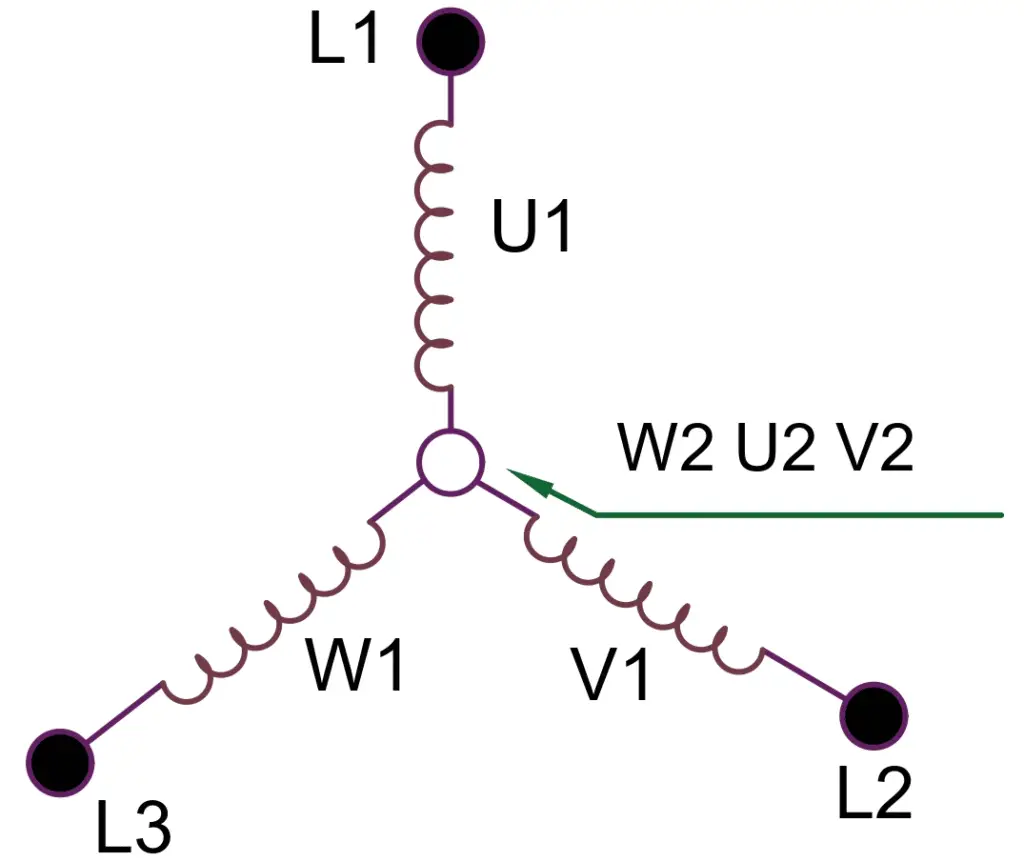
Features of the balanced star-connected motor
Equal Phase Voltages: Each phase winding in the motor has the same voltage magnitude. The change in the line voltage causes equal voltage sharing among the phase windings.
Line Voltage and Phase Voltage Relationship: The line voltage is √3 times the phase voltage. Thus, the voltage across each winding is 1/√3 times the line voltage in the star connection.

In a star connection, the line voltages are out of phase with each other and have a phase difference of 120 degrees between any two line voltages. All three line voltages have 120 degrees of electrical phase shift, and the phase voltages lead 30 degrees to the line voltages.
Equal Line and Phase Currents: In a star connection, the line current equals the phase current.

Advantages of Star Connection
Reduced Voltage Stress on Windings: As discussed earlier, the phase voltage is about 58% of the line voltage in a star connection. It means the voltage across each winding is 58% of the line voltage. Electrical stress on the motor winding depends on the voltage and a lower voltage causes less stress.
Applications of Star Connection
High-Voltage Motors: The star connection is ideal for HT(High Tension) motors because the reduced phase voltage minimizes insulation requirements. The motors of 3.3, 6,6, and 11 kV ratings have star-connected stator winding.
Motor Startup: During startup, motors connected in a star configuration draw less current This feature is used in star-delta starters, where the motor starts in star mode and switches to delta mode for full-load operation.
Energy-Efficient Systems: The lower phase voltage in a star connection improves energy efficiency in systems where motors operate under varying loads.
Low Starting Torque Applications: Motors with star connections are suitable for equipment requiring low starting torque, such as conveyors, fans, and pumps.
Safety Precautions for Star Connection of a Motor
- Take the work permit and provide the LOTO(Lockout Tagout) procedure on the motor feeder before starting the job. The purpose of this is to make sure that power supply is not available at the motor terminals.
- Ensure all terminal connections (U, V, W, and neutral) are tight and secure because loose connections can lead to arcing or overheating.
- If you’re uncertain about the connections or not acquainted with complex wiring, it is better to engage a certified technician or electrician for help.
2. Delta connection
Connecting a motor in a delta (Δ) configuration involves connecting the ends of each winding to form a closed loop, with each junction connected to a power supply phase.
The motor delta connection is shown in the diagram below.

Step-by-step Procedure for Delta Motor Connection
Here’s a step-by-step procedure for Star Motor Connection.
Step 1: Identify the Motor Terminals
Three-phase motors have six terminals, typically labeled U1, U2, V1, V2, W1, and W2.

Step 2: Determine the Winding Pairs:
The terminals are usually paired as U1-U2, V1-V2, and W1-W2. Each pair represents one of the motor windings.

Step 3: Create the Delta Connections:
Connect U1 to W2, V1 to U2, and W1 to V2. This creates a closed loop where the end point of each winding is connected to the start point of another winding, forming a triangle (delta (Δ)) shape.
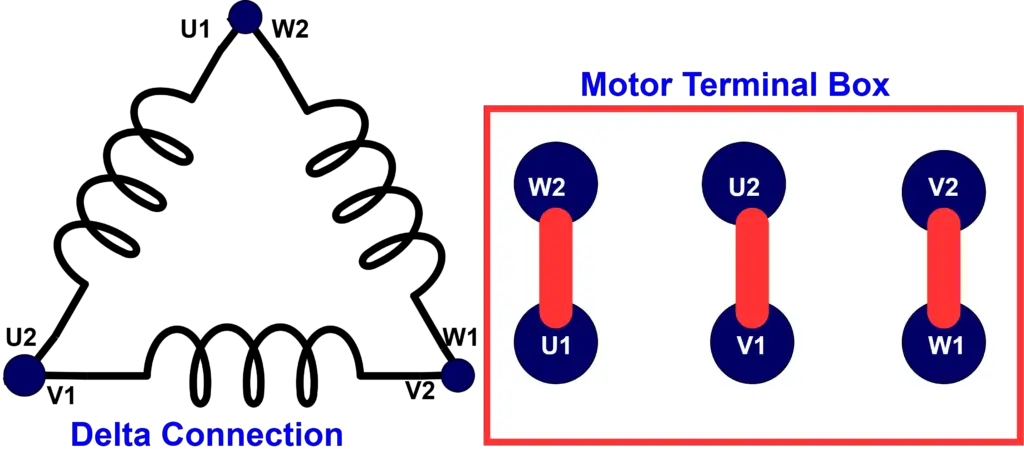
Step 4: Connect the Phases
Connect the three-phase power supply lines (L1, L2, L3) to the three junctions created in the previous step—for example, L1 to U1-W2 junction, L2 to V1-U2 junction, and L3 to W1-V2 junction.
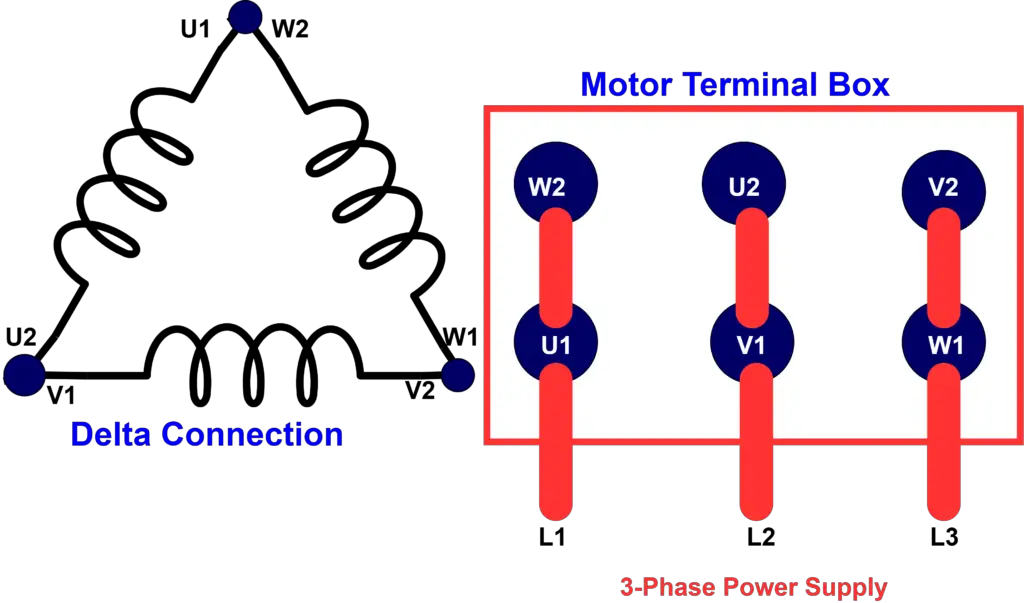
The diagram below shows how the motor windings are connected in the delta connection.
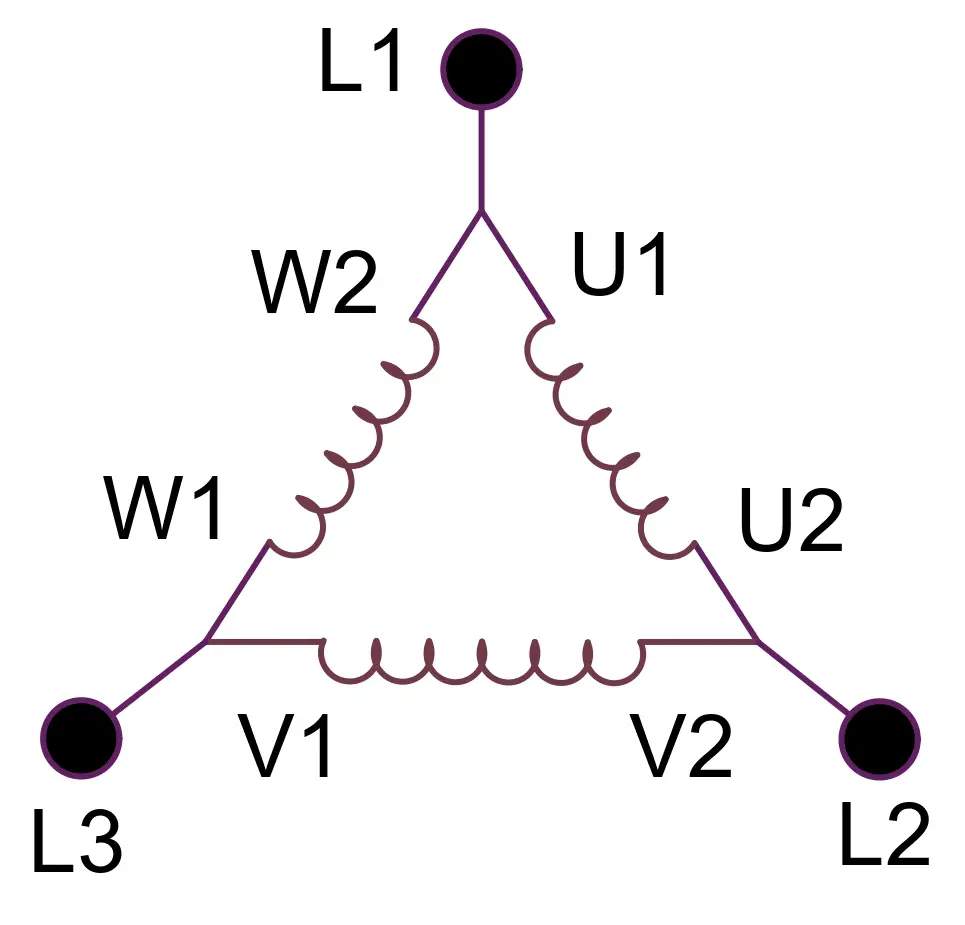
You can connect the electric motors in a star or delta configuration depending on the motor-rated voltage and the input supply voltage, You can also start the motor in a star-delta setup using a star-delta starter. To do this, the motor’s voltage rating in a delta connection should be equal to its rated supply voltage.
Features of Delta Connected Motor
Equal line voltage and phase voltage: The line voltage equals the phase voltage in the delta connection.

Relationship between Line and Phase Currents: In a delta connection, the line currents are √3 times the phase currents. In a star connection, the line currents are out of phase with each other and have a phase difference of 120 degrees between any two line currents. All three line currents have 120 degrees of electrical phase shift, and the phase current leads 30 degrees to the line current.

Advantages of Delta Connected Motor
High Starting Torque: Delta connection provides high starting torque. Therefore, it is suitable for heavy-load applications like compressors, conveyor belts, and pumps.
Fast Acceleration: The delta-connected motor has higher starting torque and can quickly accelerate up to the rated speed.
Less Copper: A delta-connected motor uses less copper, leading to cost savings.
Applications of a Delta Connection
It is suitable for those applications where higher starting torque is required. The delta-connected motors are used for driving the equipment including elevators, blowers, and conveyors.
Safety Measures of a Delta Connection
- Take the work permit and provide the LOTO(Lockout Tagout) procedure on the motor feeder before starting the job. The purpose of this is to make sure that power supply is not available at the motor terminals.
- Ensure all terminal connections (U, V, W) are tight and secure because loose connections can lead to arcing or overheating.
- If you’re uncertain about the connections or not acquainted with complex wiring, it is better to engage a certified technician or electrician for help.
Precaution for Dual-rated voltage motors
When dealing with dual-rated voltage motors (motors that can operate at two different voltage levels), It is essential to take specific precautions to maintain safe and efficient operation. It is crucial to confirm the motor’s voltage ratings and corresponding connection diagrams (star and delta configurations) on the nameplate.
If an electric motor has a nameplate indicating 690/400 (Y-Δ) volts, it can be connected in either a star or delta connection. When connected in a star connection, the motor’s optimum performance requires a supply voltage of 690 volts. However, it can also function with a lower voltage of 400 volts in the star connection, but its torque delivery will be reduced. On the other hand, when connected in a delta connection, the motor should be supplied with 400 volts. Supplying 690 volts to a delta-connected motor can cause it to burn out.
FAQs on Star Delta Connection of Motor
Q1. What is a Star Connection in 3-phase motors?
A Star Connection (also called a “Y” connection) in 3-phase motors is a method of connecting the motor’s three windings such that one end of each winding is joined to form a common point, known as the neutral or star point. The other ends are connected to the three-phase power supply terminals (R, Y, B).
In a star configuration, each winding is subjected to a reduced voltage equal to Vphase=Vline/√3, where Vline is the line voltage. This reduces the starting current and stress on the motor.
Q2. What is a Delta Connection in 3-phase motors?
A Delta Connection in 3-phase motors is a configuration in which the ends of each winding are connected to form a closed loop resembling a triangle (Δ). In this setup, each winding is connected across two phase terminals of the power supply, and there is no neutral point. The line voltage (Vline) equals the phase voltage (Vphase) in a delta connection.
Q3. When should you use Star and Delta connections?
The choice between star and delta connections depends on the operating requirements of the motor and the specific application.
- Star Connection: Use a star connection to start a motor to reduce the starting current. The reduced current causes fewer voltage drops in the power supply system. The star connection can be used for motors that drive light loads or where high starting torque is not required. Star connections are used in star-delta starters to ensure a smooth start.
- Delta Connection: The delta connection is suitable for those applications that require high starting torque or continuous heavy loads. Delta connections are used in star-delta starters during motor running for full power and higher torque.
Q4. Which connection handles more power: Star or Delta?
When you compare the power handling capacity of star and delta connections of a 3-phase motor, the delta connection has a higher capacity. In a delta connection, the motor operates at full line voltage and delivers more power and higher torque. Star-connected motors run on reduced phase voltage, therefore the star-connected motors have lower power handling capacity.
Q5. What happens when a Delta-Connected Motor is connected in Star?
If a delta-connected motor is connected in a star configuration, the voltage across each winding will be about 58% of the full line voltage. This lower voltage reduces the power and torque-delivering capacity of the motor. The motor torque depends on the voltage and is proportional to the square of the voltage. Thus, the torque of the motor will be(Vph/√3)2, and the star-connected motor will deliver 1/3 rd of the rated torque. To avoid these issues, a delta-connected motor should always be wired in the delta configuration.
Interested and wants to know more